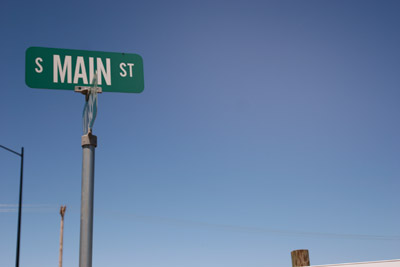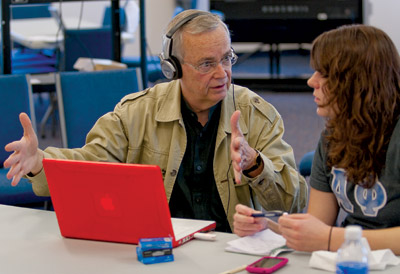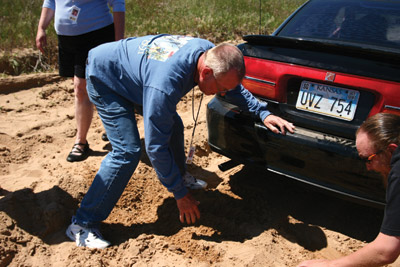
The highway leads west through the Kansas countryside. Fields on either side look like nothing is growing, but I know the seeds are probably planted and just haven’t sprouted yet. The radio is blaring and my two friends, seniors Courtney Crain and Angela Hampton, and I talk about what we expect to do in Greensburg, Kan., the small town in western Kansas that was destroyed on May 4, 2007 by an E-F5 tornado.
Our class, Greensburg Rebirth, is taught by Les Anderson, a professor in WSU’s Elliott School of Communication, and lasts two weeks at the end of May and the beginning of June. We go around the town and report on the rebuilding process using print, video, audio and photographs. My knowledge of all things country is pretty limited. Born and raised in the suburbs of Kansas City, I have lived a life sheltered from dirt roads and tractors. To put this in perspective, I was the only one of my travel companions on the way out west who had never ridden a combine. I was pretty sure that I was going to get a rude awakening to small town living, and I was right.
Arrival
As we approached Greensburg, it was hard to tell we were on Main Street. When the tornado hit, it took out most of the town’s business district. Construction was obviously under way throughout the town, but the scars left by the storm were not erased.
We rolled into the parking lot of the local Methodist church and started unpacking. I am the worst about wanting to pack my entire room and bring it with me. Two duffle bags, a full-size cooler, bedding and camp cot later, Les informed us we were going to be taking profile pictures for our blogs.
Awesome. I’ve tramped up and down stairs dragging around most of my house, and now I’m having my picture taken. The end result is a goofy-looking blog picture. (It is actually the best one. I didn’t like the first one that Cort Anderson, another instructor in the course, put up. I begged him to change it.) After this small form of photographic torture, Les set my fellow classmates and me down for a slam rundown of the course before we went on our initial tour of the town. The goal: to go out into the not-so-wide world of Greensburg and tell the stories that hadn’t been told yet. Ready. Set. Go.

gives some pointers to Greensburg Rebirth student
Molly Walsh, a print communications major at
Wichita State.
We got into the yellow school bus for our tour with our game faces on. Pens, paper, recorders and cameras out, we listened for the juiciest story idea while our guide, Matt Deighton, drove the bus, shared personal experiences, and pointed out what was rebuilt.
That tour of the town put the damage in perspective for us. There were still gaping holes in the ground and piles of debris. Houses with spray paint on the fronts from the searches for survivors by the various rescue teams.
Tree tops missing and staircases leading to nothing. Les emphasized branching out from our specialty in this class. So print people, like myself, were going to try toying with audio, video and photography.
On the second day, a few classmates and I went on the GreenTown tour lugging camera equipment along with us.
When Greensburg citizens decided to rebuild, many decided to rebuild more ecologically sound, or “greener.” But when the concept was first suggested some were not receptive.
“We thought this might be a left-wing, California fad,” says Taylor Schmidt, an intern at GreenTown, a nonprofit organization that formed to educate the people of Greensburg about going green. After learning more about the benefits, many residents became passionate about rebuilding green, although the idea still has its opponents.
Schmidt showed us how the buildings were being constructed to be energy efficient and told us that Greensburg is the first U.S. town to require all city buildings to be Leadership in Energy and Environmental Design Certified. Leed quantifies the “greenness” of a building.

business district. Kiowa County United, a
non-profit group, is working to bring in several
new businesses to Main Street, as well as
to restore the original ones. To read Walsh’s
and other students’ articles about the town’s
rebuilding efforts, visit www.greensburgrebirth.com.
After shooting as much video as I could, we trooped back to the church to start editing. The class had set up a sort of base camp on the church’s main floor in the bride’s changing room for weddings. Here is where you could find most people when they were writing and editing. By the end of the two weeks that room had started to give me cabin fever.
Once the video was edited and off to Les for a once-over, I went with some of the other students to the local Bar-H Tavern. Note to self for future small town adventures: know that most places besides the gas station will not take your debit or credit cards. Get cash.
People at the bar were friendly and welcoming. They wanted to know who we were, where we were from, what we were studying, if we had found stories yet — they wanted to know everything about us. Since a majority of the class was a 21-and-over crowd, the bar patrons welcomed us into their company. By the end of the first week, we were sitting with them and swapping jokes and stories.
But our main focus was news stories, and after that first video, I was struggling to find more. What hadn’t been told yet about this town? Before I could panic, I talked to Les who suggested I talk to Deighton again to see if there were any stories he thought needed to be told.
Deighton suggested I talk to Scott Brown, founder of Kiowa County United, a non-profit group raising money to fund the rebuilding of Main Street. Brown was more than willing to talk to me about KCU and its goals. He even gave me more contacts for people whose businesses were destroyed and who were going to rebuild in the new district.

helps a Greensburg Rebirth student dig out her car.
The interview completed, I thanked Brown and went to take some pictures of the construction. There were about seven men digging for a foundation when I arrived. The hole was right in front of the sign advertising the coming district. I had this brilliant idea that I could get down in the ditch to take a picture of the sign. A sort of in-the-action shot. I approached the workmen and politely asked if it would be ok if I got in the ditch to take some pictures.
And there was silence.
“Uh, sure, I guess,” one of them finally answered. “Just don’t step on the wet concrete.”
As I slid down into the muddy hole, I thought to myself, “This had better be an amazing shot.”
I snapped several shots, including some of the men, although they were just staring at me like I was crazy. Then I was faced with the problem of getting back out. Suffice it to say, my front was pretty much covered in dirt by the time I got back to the church.
If I thought construction ditches were going to be the dirtiest story I did, I was wrong. Marathana Prothro, a student in the class and now a graduate teaching assistant in the Elliott School, asked me if I’d come shoot video of her landfill story. Landfill? As in garbage? Not exactly my cup of tea, but I needed another story.
We drove out to the landfill in the late morning, passing fields of wheat. There were piles of metal and glass and concrete on the horizon. We talked to Eric Peters, supervisor of the Kiowa County South Landfill, who told us they were still not caught up from all the debris that was brought to the landfills after the tornado. Peters even took us on a tour of the landfill. As I tramped through the trash, I realized that, as gross as this was, I was enjoying myself. How many people take a tour of a landfill filled with tornado debris in their lifetime?

self shooting video of a tornado-debris-filled landfill.
Along with learning the skills of my trade, I learned many things about small towns.
One. Just because there are cross arms and lights at the railroad crossings, it does not mean that they will come down when a train is coming. I was driving Hampton and another classmate and midway across the tracks, Hampton turns and yells, “Molly, there’s a train coming!” Oops?
Two. If you are driving along a dirt road and you see a sign that says “Minimum maintenance travel at your own risk,” unless you have a truck, SUV, or all-wheel drive, stop! Do not keep going. Luckily, I learned this vicariously through another classmate we had to go dig out of the dirt. If not for the help of a local young man who had experience with this, we might still be digging her out.
Three. Small towns shut down early. The lights are out by about 11 p.m. Even the bar closed at 10 p.m. on weekdays and midnight on weekends.
Four. People will make fun of you if you tell them that up until four years ago, you had no idea what a grain elevator is or what it does.
Another student in the class, Rebecca Zepick, would later call the class a “boot camp for reporters,” and I couldn’t put it better. The two weeks ended with five stories and many experiences. Most of our time was spent out at interviews or back at the church writing and editing.
While I am more sure than ever that I am a true city girl at heart, I have a new appreciation for the small-town way of life. People want to know how you are and about your life. They offer complete strangers their jacket if it’s cold outside and just ask that you bring it back. They have a whole different set of knowledge (that I seriously lack) but are willing to teach you.
Greensburg the town may have been nearly flattened by a tornado, but friendship and the sense of community thrive.





